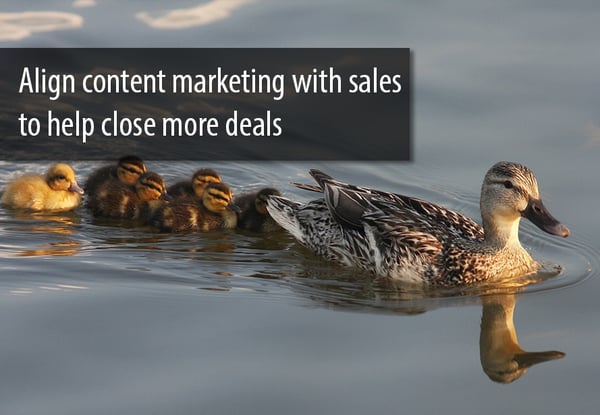How to Use Your Website for Sales Enablement
 Have you heard this catchy phrase? "Your website is your best salesperson." We've heard it, too -- and we've repeated it on our blog because to a point, it's true. However, it may be time to shift that perspective.
Have you heard this catchy phrase? "Your website is your best salesperson." We've heard it, too -- and we've repeated it on our blog because to a point, it's true. However, it may be time to shift that perspective.
Rather than thinking about your website as a standalone part of your sales team (constantly generating leads behind the scenes), it may be more beneficial to think about it in terms of sales enablement.
Such an approach will not only help your sales team connect with prospects at the right point in the funnel (sales funnel, that is) and have more meaningful conversations, it will also help web designers and marketers align their efforts with sales to create a consistent and accurate message for your brand and your products or services.
Why is this important?
Depending on the number of members on your sales team, each individual may be producing or tweaking their own emails, presentations, decks, and collateral material for prospects. Is that content consistent in style and format from rep to rep? Does it reflect your key marketing messaging? Does it look professional? And, maybe most importantly, should your sales reps be spending their time on creating one-off content?
Probably not.
Remember, buyers (even B2B customers) are increasingly eager to do their own research online. They seek out information when it's convenient for them. Buyers also like being in control of the different types of content they consume as well as the quantity they take in before reaching out to a salesperson. By creating content focused on issues and pain points reps hear on a consistent basis, you can help your team avoid creating the same pieces over and over and ensure the materials are accurate and consistent. At the same time, you can focus on content marketing your sales reps will actually use.
An American Marketing Association study reports that 90% of marketing deliverables are not used by sales.
Why aren't your sales reps using the content you produce?
1. The content is not relevant.
This problem affects web design, content creation, and sales. If a piece of content or key messaging is based on a buyer persona and their journey to becoming a customer, you may need to update the persona using input from your reps. Listen in on sales conversations and meetings -- take a rep out for lunch. The point is to gain insights on prospects to improve your key messaging, blog posts, premium content offers, email marketing, and social media marketing.
2. The content is not easily accessible.
Are you using a shared drive for reps to gather appropriate content for prospects? Or, are you still emailing content back and forth with your team? How about using different areas of your website to deliver useful information? By positioning your website as a tool for sales enablement, your reps can point prospects (that aren't quite ready to purchase) back to the site for additional resources while continuing their path to purchase on their own terms.
So, how do you get started using your website for sales enablement?
- Start by communicating with your sales team and updating any stale buyer personas. Don't have any? Get started here.
- Create and post educational content for different buyer personas and stages within the sales and marketing funnels. Examples of educational blog content: Heckard's Door Specialties, The Ross Group, Pronto.
- Organize and map your content and provide reps with suggestions for using specific areas of your website.
- As new content is created and updates to the site become live, touch base with your reps on how they can leverage the material using email templates and copy created by marketing.
- Create personalized landing pages for your sales reps detailing their bio, what they can offer, and additional useful information for prospects. These pages are extra effective if they include a personal message from the rep and their headshot. Examples of personalized landing pages: HubSpot's Ali Powell and Chad Larsen of Berg Larsen Group.
- Develop a resource center page to house premium content offers in one space. Navigation to your resource center should be placed in highly visible areas throughout your site.
- Create engaging calls to action that drop website leads into marketing automation workflows. Encourage your reps to place leads into these same workflows. Bonus tip: Set a trigger in the workflow to send reps a notification to prompt a follow-up call once a lead has finished the nurturing cycle.
We often say "your website is your best salesperson" to get businesses thinking about the performance of their current site. We can all agree that static, brochure sites have gone the way of the dodo. But, if you already have a website that is generating some leads for your business, is it fully optimized to continue the nurturing process and deliver more qualified leads to sales?
By looking at your website from a sales perspective -- how it can be used for sales enablement -- you can create a variety of content that is targeted, organized, accessible, linked, and measurable. All of which, will allow your sales team more time to focus on strategic conversations that end in new customers.
Learn more about aligning your teams with our FREE Sales and Marketing Alignment Checklist.

